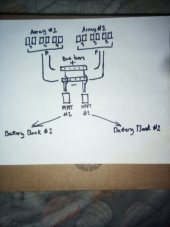I have two arrays. Each array has six panels. The panels are wired as 2S3P on each array. Currently I have each array connected to it's own Epever Tracer 4210an. Each MPPT feedings it's own battery bank. Bank #1 is 24v Flooded 660amp. Bank#2 24v Lifepo4 400amp.
Is it possible to tie in all arrays into a positive and negative bus bar group and then connect the mppt's to the bus bars to feed the charge controllers?
Is it possible to tie in all arrays into a positive and negative bus bar group and then connect the mppt's to the bus bars to feed the charge controllers?



